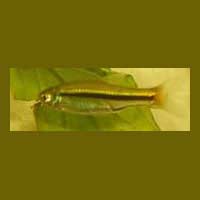Rasboras

Brightly coloured friendly and highly active, rasboras are an aquarium favourite. Their peaceful nature makes them a great choice for a community tank and their natural hardiness means that they're ideal starter fish for the beginner aquarist. They adapt well to aquarium conditions and can be delightful to watch.
Rasboras are schooling fish and are happiest in groups of six or more. Averaging about two inches in length, they get on well with other schooling fish of about the same size. For best results, keep them in a densely planted tank with plenty of hiding places. They like slightly acidic water, so bogwood is also a good choice, providing cover and lowering the pH of the water at the same time. Make sure there are some floating plants on the surface of the water so that your rasboras feel more secure. They can become distressed if directly exposed to bright light for too long.
Rasboras are carnivorous fish and do best on a diet with lots of live food (such as daphnia, bloodworm and crustaceans), though they will also accept flakes. Although they can adapt to a variety of water conditions, they are quite sensitive to sudden changes, so you should be particularly careful when carrying out partial water changes or moving them between tanks.
Types of Rasboras
Although some species of rasbora are now endangered in the wild, they have been bred successfully within the aquarium trade, and there are several varieties available to buy:- Harlequin Rasboras - The most popular kind of rasbora, these lively little fish have distinctive black triangular markings and red-tipped tails. They are hardy, adaptable, and relatively easy to keep.
- Dwarf Rasboras -With their bright, jewel colours and striking patterns, these delightful little fish are very popular, but they are delicate and are the most difficult kind of rasbora to keep successfully. They need a tank with very good filtration.
- Emerald Eye Rasboras -Attractive, highly gregarious fish with distinctive black dots on their dorsal fins, these are very active, hardy and easy to keep.
- Red Stripe Rasboras -These fish only display the stripe in their name when they're healthy and happy, so it's easy to tell how they're doing. They can be sensitive to pollutants and are difficult to breed.
- Scissortail Rasboras -Also known as three stripe rasboras, these bright, silvery fish have a distinctive swimming style. Lively and sociable, they're an excellent choice for community tanks.
As a rule, rasboras of different species get along well and can be kept together, but they're much happier if kept with others of their own kind.
Breeding Rasboras
Rasboras are not easy to breed, but if you are patient and give them plenty of attention you can expect to be rewarded. Sexing them is fairly easy - females are larger and more full-bodied than males, and the markings on males tend to be more angular. If you watch your shoal of rasboras carefully you will soon identify couples forming within it. Rather than stress them when they are just about to spawn, you should move a suitable couple into a separate spawning tank as soon as they start to become physical with each other (close swimming, chasing and nudging in the belly). The spawning tank should be heavily planted with a gravel substrate, providing plenty of places for sticky eggs to attach. Spawning will begin first thing in the morning and you should remove the parent fish immediately afterwards, as they will eat their own eggs.Once the adult fish have been removed, their eggs should be kept in the dark to protect them from fungus. Rasbora fry can be difficult to rear. They will accept most commercial fry food preparations but should not be given infusoria, which can damage them. With luck, you can expect to raise about ten fry to maturity from each clutch of two hundred eggs.
Energetic and sociable as they are, rasboras can be great fun to keep. They're remarkably easy-going and simple to look after, and if you treat them well you'll be richly rewarded.


Re: Providing Toys for Your Fish
Toys for my baby Flowerhorn fish??? And where to buy them ?
Re: Snail Infestations in Your Fish Tank
My coy fish just started darting and running into the glass. I've checked them over and see nothing on the outside of…
Re: My Pet Fish is 20 Years Old is this a Record?
I purchased a gold fish on April 1997 for my daughters and the same fish is alive and well. The reason I'm…
Re: Dealing with Bullying Between Fish
I have 3 Bolivian butterfly rams not sure the genders,but at the start all 3 were fine but just recently we’ve notice 2…
Re: Using Electrical Devices Safely In Your Aquarium
Monthly water changes isn’t enough I would be changing at least a 1/3 weekly. I do it more often than…
Re: Dealing with Bullying Between Fish
I have a blue gourami that has been living with 4 platty’s and a yoyo loach. I noticed a couple of my fish missing. I…
Re: Lighting for Aquatic Animals
Will a UV submersible light harm my tropical tank and fish. Thanks for any help
Re: Dealing with Bullying Between Fish
Recently put 12 new Africans in my 55 gallon tank. Many rocks and hiding places. After 2,3 days one of them, obliquidens,…
Re: Food Quantities
Just noticed smallest neon tetra tail is missing and white on the edges. Another also has half of tail missing. They was OK a few days ago. I only…
Re: Providing Toys for Your Fish
I have guppies and I think the ideas for toys might be too big, I have tried training them but they aren't responding.